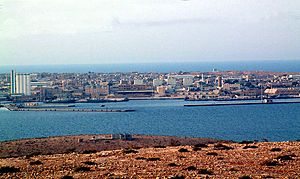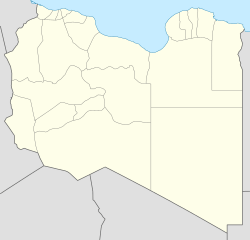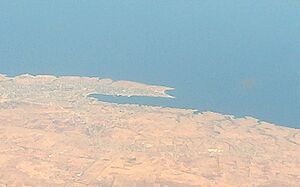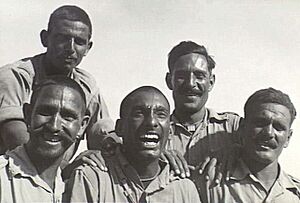Tobruk facts for kids
Quick facts for kids
Tobruk
طبرق
Tobruch |
|
|---|---|
|
City
|
|

Panorama of Tobruk
|
|
| Country | Libya |
| Region | Cyrenaica |
| District | Butnan |
| Elevation | 5 m (16 ft) |
| Population
(2011)
|
|
| • Total | 120,000 |
| Time zone | UTC+2 (EET) |
| License Plate Code | 14 |
Tobruk (also spelled Tubruk) is an important port city located on the eastern coast of Libya. It sits right by the Mediterranean Sea, very close to the border with Egypt. Tobruk is the main city of the Butnan District and has about 120,000 people living there (as of 2011).
This city has a long history. It was once an ancient Greek settlement and later a Roman fort. For many centuries, Tobruk was a key stop for traders traveling along the coast. In 1911, it became an Italian military base.
During World War II, Tobruk saw a lot of fighting. Allied forces, including Australian soldiers, captured it in January 1941. It was then under a long siege by German and Italian forces. Even though the siege was lifted later that year, the Axis powers recaptured Tobruk in June 1942. The Allies finally took it back in November 1942.
After the war, Tobruk was rebuilt. In the 1960s, its port was made bigger and connected to an oil pipeline from the Sarir oil field. Tobruk was also a strong supporter of the Senussi royal family and was one of the first cities to rebel against Muammar Gaddafi during the Arab Spring.
Contents
Geography of Tobruk
Tobruk is known for its natural deep harbour, which is very well protected. It's considered one of the best natural ports in northern Africa. However, because there aren't many large towns nearby, it's not the busiest port. The city is mostly surrounded by desert, where some nomadic herders live, moving between oases.
South of Tobruk, you'll find many escarpments, which are like steep cliffs. These cliffs are common in Cyrenaica, the eastern part of Libya. They create a big natural barrier between the northern and southern parts of Libya around Tobruk.
Tobruk is an important meeting point for traders and travelers from both Egypt and Libya. It's about 150 kilometers (93 miles) from Egypt by land. It's also a key stop for people traveling from other Libyan cities like Bayda and Derna.
The city faces a problem with saltwater intrusion, where saltwater gets into the freshwater supply. To help with this, a factory has been built to remove salt from seawater, a process called desalination.
Climate in Tobruk
Tobruk has a hot desert climate. This means it's usually very hot and dry. However, because it's right by the sea, it gets more rain than places further inland in the Sahara desert.
| Climate data for Tobruk (1991-2020) | |||||||||||||
|---|---|---|---|---|---|---|---|---|---|---|---|---|---|
| Month | Jan | Feb | Mar | Apr | May | Jun | Jul | Aug | Sep | Oct | Nov | Dec | Year |
| Record high °C (°F) | 26.1 (79.0) |
34.5 (94.1) |
39.5 (103.1) |
42.6 (108.7) |
43.0 (109.4) |
44.6 (112.3) |
44.7 (112.5) |
41.8 (107.2) |
42.6 (108.7) |
40.5 (104.9) |
34.0 (93.2) |
29.8 (85.6) |
44.7 (112.5) |
| Mean daily maximum °C (°F) | 17.6 (63.7) |
18.4 (65.1) |
20.5 (68.9) |
23.0 (73.4) |
25.3 (77.5) |
27.7 (81.9) |
29.4 (84.9) |
30.1 (86.2) |
29.4 (84.9) |
27.2 (81.0) |
23.4 (74.1) |
18.4 (65.1) |
24.2 (75.6) |
| Daily mean °C (°F) | 13.7 (56.7) |
14.3 (57.7) |
16.1 (61.0) |
18.5 (65.3) |
21.3 (70.3) |
24.1 (75.4) |
26.1 (79.0) |
26.9 (80.4) |
26.0 (78.8) |
23.3 (73.9) |
19.3 (66.7) |
15.3 (59.5) |
20.4 (68.7) |
| Mean daily minimum °C (°F) | 9.8 (49.6) |
10.1 (50.2) |
11.7 (53.1) |
14.0 (57.2) |
17.2 (63.0) |
20.6 (69.1) |
22.9 (73.2) |
23.8 (74.8) |
22.6 (72.7) |
19.7 (67.5) |
15.2 (59.4) |
11.2 (52.2) |
16.6 (61.9) |
| Record low °C (°F) | 2.1 (35.8) |
0.8 (33.4) |
5.0 (41.0) |
4.5 (40.1) |
4.8 (40.6) |
12.0 (53.6) |
11.0 (51.8) |
15.4 (59.7) |
11.8 (53.2) |
10.5 (50.9) |
6.6 (43.9) |
3.4 (38.1) |
0.8 (33.4) |
| Average precipitation mm (inches) | 46.5 (1.83) |
30.3 (1.19) |
9.7 (0.38) |
3.1 (0.12) |
7.5 (0.30) |
0 (0) |
0 (0) |
0 (0) |
1.6 (0.06) |
15.6 (0.61) |
15.6 (0.61) |
43.1 (1.70) |
173.0 (6.81) |
| Average precipitation days (≥ 0.1 mm) | 5.9 | 4.2 | 2.0 | 0.8 | 0.6 | 0.1 | 0 | 0 | 0.4 | 2.0 | 2.7 | 5.2 | 23.9 |
| Average relative humidity (%) | 70.4 | 67.9 | 67.2 | 68.0 | 71.2 | 75.0 | 76.8 | 77.6 | 71.9 | 69.8 | 68.9 | 68.7 | 71.1 |
| Mean monthly sunshine hours | 232.5 | 299.5 | 288.3 | 246.0 | 306.9 | 348.0 | 350.3 | 331.7 | 288.0 | 257.3 | 285.0 | 179.8 | 3,413.3 |
| Source 1: NOAA | |||||||||||||
| Source 2: Deutscher Wetterdienst (Sunshine 1996–2015), Weather Online | |||||||||||||
History of Tobruk
Ancient Times
The area where Tobruk now stands was once an ancient Greek farming settlement called Antipyrgos. This name meant "across from Pyrgos," referring to a place in Crete across the Mediterranean Sea. Later, during the Roman era, it became a Roman fortress that protected the border of Cyrenaica.
As Christianity spread, Antipyrgos became a place where a bishop lived. Today, the Catholic Church still lists Antipyrgos as a "titular see," which means it's a historical bishopric without a current bishop. After the Roman times, the site became a resting stop for caravans traveling along the coast.
Tobruk in World War II

At the start of World War II, Libya was an Italian colony. Tobruk became a very important location for battles between the Allies and the Axis powers.
Why Tobruk was Important
Tobruk was important for several reasons:
- Great Harbour: It had a deep, natural, and protected harbour. Even if the port was bombed, ships could still anchor safely. This made Tobruk an excellent place to bring in supplies for fighting in the desert.
- Strong Defenses: The Italians had built strong defenses around Tobruk before the war. There were also natural cliffs (escarpments) to the south, making it hard for enemies to attack by land.
- Strategic Location: Tobruk was on a peninsula, which meant fewer soldiers were needed to defend it. If an enemy tried to go around Tobruk, the soldiers inside could cut off their supply lines.
- Control of Cyrenaica: Whoever controlled Tobruk could advance through the desert to Benghazi, cutting off enemy troops along the coast. This was very important for controlling the region of Cyrenaica.
- Airfield: About 24 kilometers (15 miles) south of the port was the largest airfield in eastern Libya. Air power was crucial in desert warfare.
Battles for Tobruk
In September 1940, Italian forces invaded Egypt but soon stopped and dug in. In December, British Empire forces launched a counter-attack called Operation Compass. They pushed the Italians back, and Tobruk was captured by British, Australian, and Indian forces on January 22, 1941.
Italy then asked for help from Germany, who sent the Deutsches Afrika Korps (DAK) led by Lieutenant-General Erwin Rommel. These forces pushed the Allies back, leaving Tobruk isolated and under siege. The defenders included Australian, British, Polish, and Czechoslovak soldiers. The siege lasted until December 1941, when Operation Crusader pushed the Axis forces back.
Rommel's second attack happened in May and June 1942. Tobruk was captured on June 21, 1942. This was a big victory for the Axis, and Rommel was promoted to Field Marshal. Many Allied units were captured, including the 2nd South African Infantry Division.
The British tried a special raid on Tobruk in September 1942, called Operation Agreement, to destroy port facilities. However, it did not go as planned, and the British suffered many losses.
Tobruk remained in Axis hands until November 11, 1942. The Allies recaptured it after the Second Battle of El Alamein. After this, Tobruk stayed under Allied control for the rest of the war. The British even built a railway line from El Alamein to Tobruk, which helped with supplies and boosted the morale of the Allied troops.
Libyan Civil Wars
At the beginning of the First Libyan Civil War in 2011, Tobruk quickly came under the control of the NTC, which was the group opposing the government. In 2014, the internationally recognized government of Libya moved its operations to Tobruk. A different parliament continued to operate in Tripoli. Later in 2014, the government in Tobruk moved to a hotel called Dar al-Salam.
Famous People from Tobruk
- Professor Omar El Barasi (born 1951) is from Tobruk. He used to manage the Libyan branch of the Society of Petroleum Engineers and later became a deputy to Libya's Prime Minister. He studied petroleum engineering in Japan.
- Eman al-Obeidi is a Libyan woman from Tobruk who became known during the First Libyan Civil War in 2011.
- Omar Mukhtar, a famous Libyan resistance leader, was born near Tobruk.
Getting Around Tobruk
The city is served by Tobruk Airport, which has flights from two major domestic airlines.
Images for kids
See also
 In Spanish: Tobruk para niños
In Spanish: Tobruk para niños





